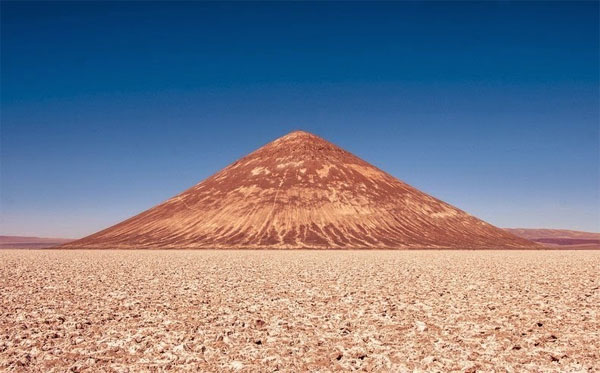Volcanic pyramid in Argentina
Cono de Arita is shaped like a large pyramid, but is thought to be a volcano not strong enough to erupt lava.

Cono de Arita is shaped like a large pyramid between the salt lake Salar de Arizaro.(Photo: Amusing Planet)
Cono de Arita volcanic pyramid is located on the southern border of Salar de Arizaro salt lake area, northwestern Argentina. Cono de Arita is 120m taller than the salt lake surface. The conical structure "grows" up from the central area of the salt lake, characterized by a large pyramid. In Aymara, "Arita" means "sharp."
In recent years, it is thought that the perfect structure like the pyramid of Cono de Arita was built by human hands. However, in fact, Cono de Arita is a natural structure. It is said to be a small volcano, but it is not strong enough to erupt or use a volcano.
According to Amusing Planet, around this structure is black salt, brought to the surface by the ancient underground magma currents. According to archaeological research results, it used to be a center that carried out many ritual activities, dates before the Incas appeared.
Salar de Arizaro is a large salt lake in the Andes region, bordering Chile. Salt lake covers an area of about 1,600 km 2 . This is considered the second largest salt lake in Argentina and the sixth largest salt lake in the world. This area is exploited to search for metal and non-metallic resources such as salt, marble .
- Two theories about volcanic pyramids in Peru
- Secret of the red pyramid in Egypt: After 141 years of decoding a part
- Pyramids cost 5 billion USD
- Mystery of the American Pyramid
- 25 unexpected facts about the Egyptian pyramids
- Mysterious pyramid in Peru makes archaeologists' crazy
- Pyramid: The most mysterious architecture of mankind
- Mysterious around the oldest pyramid in Egypt
- Discovering the first pyramid of humanity, building 1000 years before the Egyptian Pyramid
- Unusual heat in the Egyptian pyramid
- The hidden room in the Great Pyramid may contain the pharaoh's throne
- The priceless treasures under the Mexican pyramid
 Is the magnetic North Pole shift dangerous to humanity?
Is the magnetic North Pole shift dangerous to humanity? Washington legalizes the recycling of human bodies into fertilizer
Washington legalizes the recycling of human bodies into fertilizer Lightning stone - the mysterious guest
Lightning stone - the mysterious guest Stunned by the mysterious sunset, strange appearance
Stunned by the mysterious sunset, strange appearance